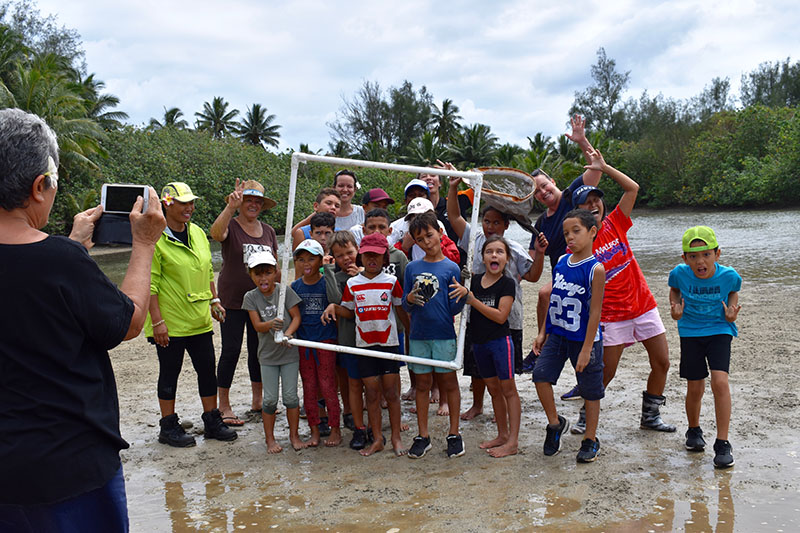‘Muddy buddies’ eco stream walk
Saturday 16 October 2021 | Written by Te Ipukarea Society | Published in Opinion

Some of the Muddy Buddies at Aroko Salt Marsh with a photoframe/quadrant used for counting Kō'iti Raukura (fiddler crab) burrows. Photo: Tinirau Macquarie/21101549
For a fun school holiday activity this week, Te Ipukarea Society (TIS) and Muri Environment Care (MEC) invited kids on an eco-walk along Muri’s Aremango stream and the Aroko salt marsh, writes Te Ipukarea Society.
It was an opportunity to get muddy and learn about the stream and lagoon environment, while chatting about what they found, including freshwater fish, crabs, plants, and birds.
Using a handy fishing net, we got to look at the koura vai (freshwater bracelet prawns) and other little fish such as the iku kai-namu (gambusia) which were introduced pre-1960s as biocontrol to catch mosquitoes, and which now dominate many streams.
There was a lot of curiosity around all of the stream critters, especially the many tuna eels that generated some impressive responses from the tamariki.
Learning about healthy streams requires an understanding of what makes up healthy soil. Brennan Panzarella did a ‘jar test’ demonstration to identify different types of soil in Rarotonga and how sediment can be a problem for stream and lagoon life after big rains.
The students experimented with different types of soil, ranging from sandy and clay, to soil with more organic content.
Then they added water to jars of different soil types and shook them to see the separation of layers of sand, silt and clay. From this, the students could see that finer soil took longer to settle than other types of soil.
The next step was to take a look at the planting along the Aremango stream. Stream banks planted with vegetation will be less likely to erode than those left bare or with shallow rooted grass. Diverse plants with good root systems will add organic matter back into the soil, which in turn will support a healthy soil structure.
In a nutshell, well planted stream banks means less sediment in our streams and lagoon, which is better for our freshwater and marine life.
Next we went to the Aroko mud flats – the only remaining saltwater marsh in Rarotonga – to learn about its importance as the habitat of crabs and seabirds. The mauku ta’atai grass (saltwater paspalum) has suffered from the sediment that was deposited this past winter, but appears to be growing back.
We also spotted several of the migratory kuriri bird (wandering tattler), the long distance travellers from Alaska.
Using a quadrant to measure the Kō'iti Raukura (fiddler crab) habitat at the Aroko salt marsh, we were able to compare how many burrows could be found in different areas and whether the crabs had also been affected by the heavy deposit of sediment coming from the surrounding hills.
Eight-year-old Ari George took on the self-appointed job as news reporter, interviewing some of the muddy buddies with a GoPro video camera, asking questions such as “do you like streams?”
Graham Richards (9) said: “I don’t like them because they are stinky”, while Kevin Aviu (8) said: “My favourite part of the programme was seeing the eels”.
Khan V (8) agreed, saying that he “enjoyed being in the stream and seeing the eels and the fish”.
Tinirau Macquarie (12) said what he enjoyed most was taking photos with the cameras we had provided for some of the older kids. He did an awesome job capturing our Muri stream environment.
Paikea Macquarie (10) said, “learning about the kangkong vines was fun.” They learned that kangkong water spinach grows 4 inches every day with shallow roots and can be invasive in our streams.
After all that activity it was time for the kids to draw or paint their interesting discoveries on a giant poster and enjoy lunch back at LBV cafe, generously sponsored by MEC.
It was great to see just how much interest there is in nature walks and we fully intend to do this again soon, focusing on different stream areas.
It's always fun for kids to get into nature, to get their feet muddy and experience first hand what lives in our natural environment.




































